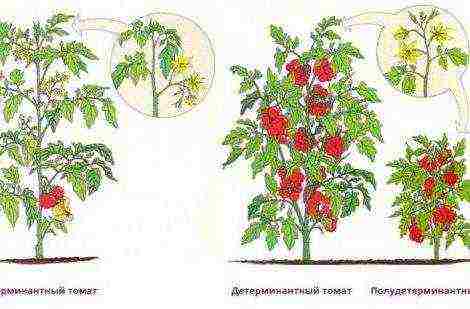Content

According to the ripening period, beets are divided into early, mid-ripening and late. For winter storage, the second and third are suitable. Early and ultra-early beets are good because they ripen in 2-3 months, but they do not lie well.
Using personal experience, reviews of gardeners from the forum and neighbors in the country, I will describe the best yielding varieties of beets.
The best early varieties of beets, descriptions, reviews
Egyptian flat beet
Early maturing (from germination to harvesting 95-115 days) beet variety. Root crops are flat-round, dark red, weighing 200-400 g. The flesh is red with a purple tint, juicy, good taste.
Advantages of the variety: stable yield, resistance to drought and flowering, suitability for long-term storage.
Egyptian flat sekla is suitable for all types of culinary processing.
Beet yield Egyptian flat: 5 - 8.3 kg per sq.m.
Beetroot Red ball improved
Ultra-early (72-78 days from germination to harvest) high-yield beet variety. Root crops are even, rounded, weighing 150-250 g. Their flesh is dark red, tender, juicy, sweet, almost without rings, quickly cooked.
Advantages of the variety: amicable yield of the harvest, high commercial qualities, good keeping quality. Recommended for home cooking, as well as baby and diet food.
Beet yield red ball: 3 - 6 kg from 1 sq.m.
Bordeaux beet 237
Medium early variety (period from full germination to technical ripeness 95-110 days). Root crops are round, weighing 200-500 g, with dark red pulp and excellent taste.
Advantages of the variety: comparative heat resistance, high yield in all weather conditions, good keeping quality during winter storage. Recommended for cooking and processing. Due to the rapid overgrowth of root crops, later and thickened crops are recommended.
Beet yield Bordeaux 237: 4 - 8 kg from 1 sq.m.
Cold-resistant beets 19
A mid-early variety of beets, the period from full sprouting to technical ripeness is 66-76 days. Root crops are flat-rounded, dark red, smooth, weighing 150-220 g. The pulp is juicy, tender, with excellent taste.
The variety is suitable for growing on a bunch during podwinter and early spring sowing. Used fresh, for processing and long-term storage.
Advantages of the variety: cold resistance, suitability for winter sowing, resistance to flowering, good keeping quality.
Beet yield Cold-resistant 19: 4-7 kg from 1 sq.m.
Mid-season beet varieties, description, photo
Bohemian beet
A mid-season variety (from the moment of germination to ripening, 70-80 days pass) of table beet. Root crops are rounded and flat-rounded, with a maroon color. The pulp is maroon, juicy and tender, without rings, with excellent taste. The weight of one fruit is 300-500 g.
Advantages of the Bohemian variety: resistance to cercosporosis and flowering, does not require thinning, good keeping quality.
Beet yield Bohemia - up to 4.8 kg from 1 sq.m.
Bona beet
High-yielding mid-season beet variety (period from germination to harvesting 115-120 days). Root crops are rounded, large, aligned, smooth, dark red. The pulp is evenly colored, without rings, has excellent taste.
Advantages of the variety: large root crops have high commercial qualities and good keeping quality.
Beet yield of Bona: 5.5 - 6.8 kg per sq.m.
Detroit beet
The most common mid-season beet variety (100-110 days pass from germination to ripening).Root crops of the correct, rounded shape, the same size, with a smooth skin, deep red color, without rings. The weight of the roots is about 250 g. The rosette of leaves is not dense.
Advantages of the variety: resistance to shooting, high yield, even fruits with good marketable qualities, excellent keeping quality. Suitable for both long-term storage and processing.
Beet yield Detroit: 3.6 - 6.9 kg per sq. m.
Beet Incomparable A 463
Medium-early high-yielding, cold-resistant beet variety, 70-100 days pass from germination to harvest. Root crops are rounded and flat-rounded, weighing 170-400 g, dark red with a burgundy tint.
Advantages of the variety: cold-resistant, resistant to flowering and cercosporosis. Possesses good keeping quality.
Beet yield Incomparable А 463: 2.9 - 7.0 kg per sq.m.
Agricultural technology: sowing May 1-15, sowing scheme 30 x 7 cm, harvesting July 25 - September 5.
Beet mulatto
New mid-season variety (from germination to harvesting 120-130 days).
Root crops are rounded, leveled, smooth, maroon color, weighing 150-350 g. The pulp is red, without rings, juicy, tender, with excellent taste. Preserves color when heat treated. Ideal for winter storage.
Sowing with seeds in the ground in late April - early May to a depth of 2-4 cm, with row spacing of 25-30 cm and a distance between seeds of 7-8 cm.
Beet yield Mulatto: 2.5-4.4 kg from 1 sq.m.
The best late varieties of beets, description, photo
Renova beet
Late-ripening, high-yielding variety with long cylindrical dark pink roots. From mass shoots to technical ripeness, 100-110 days pass.
Root crops are leveled, weighing 180-350 g, with dark purple juicy, tender, dense pulp, without rings.
Advantages of the variety: good keeping quality for 6-7 months, while not losing taste.
Renova beet yield: 7-9 kg from 1 sq.m.
Beet Cylinder
Medium late (120-130 days) beet variety. Root crops are cylindrical, 5-9 cm in diameter and 10-16 cm long, weighing 180-250 g, with a thin skin. The pulp is juicy, sweet, dark red, without rings.
The Cylinder variety is distinguished by good keeping quality and resistance to the main diseases of beet. Possesses excellent taste.
Cylinder beet yield: 7-10 kg from 1 sq.m.
Beets prefer fertile sandy loam soils. Seeds are sown in the ground in the second half of May. The seeding depth is 2-4 cm, the distance between the rows is 30 cm, between the seeds is 7-8 cm.
Beets are responsive to the application of potash fertilizers, ash. During the entire growing season, loosening of row spacings, weeding, thinning of seedlings is carried out. Water the beets depending on the weather conditions, they do not tolerate waterlogging.
For winter sowing, seeds are sown at the end of October to a depth of 4-6 cm.
The best precursors for beets are early potatoes, onions, cucumber, pumpkin, and squash.
We recommend purchasing beet seeds of excellent quality in the Sady Rossii online store.
Beetroot is one of the oldest vegetable crops that people grew 2 thousand years ago. Due to its unique ability to acclimatize and ease of maintenance, it can be cultivated in regions with warm and cold climates. More than 70 varieties of this vegetable are known to modern breeders and gardeners, which differ in external characteristics, ripening times and yield.
Choosing the best varieties of beets
Beets can range in color from raspberry to deep purple. It is believed that the most useful and tasty fruits are intense color without pronounced light rings. It should be noted that such a statement can hardly be called a serious delusion, since
beet color is due to the high concentration of anthocyanins - these are natural antioxidants, which also have antiseptic and vaso-strengthening properties.
Beets can be of different shapes, sizes and shades.
The color and taste of the fruit depend on several factors, but the characteristics of a particular variety play the main role in this case. So, what varieties of this extremely useful vegetable are considered the most useful, tasty, and most suitable for planting in a personal plot?
Early maturing varieties
|
One-sprout |
80-130 | 300-600 | Round or slightly flattened fruits of a bright maroon hue, tender and very juicy flesh | An early ripeness variety that usually begins the beet season. It gives a fairly large harvest, and has one valuable feature - the presence of only one sprout in the glomerulus, so that the planting does not have to be thinned out |
|
Improved Red Orb |
72-78 | 150-250 | As the name implies, the fruits of the Red Ball are aligned and round, the pulp tastes very delicate, and has excellent tasting characteristics. | The fruits contain many beneficial substances and are often used for medicinal purposes. Other advantages include the simultaneous ripening of the crop and excellent preservation of root crops in the cold season. |
|
Winter |
55 | 200-300 | Rounded, juicy roots of intense dark red color. There are no cross rings on the cut | The variety is especially recommended for winter planting. Under favorable conditions and proper care, the yield of "Podzimney" can be significantly higher than that of other early-maturing varieties. In addition, such an unpleasant phenomenon as flowering is not typical for her. |
|
Boltardi |
100-110 | 150-350 | Smooth, medium-sized fruits that have a smooth skin and a uniform dark cherry flesh without ringing (sometimes, ringiness may be mild) | Due to its excellent commercial characteristics, this variety is especially common in small farms that grow vegetables for sale. Has good plasticity, resistance to the appearance of arrows. Root vegetables are versatile, meaning they can be eaten fresh, canned or stored |
|
Egyptian flat |
110-130 | 300-500 | Small oval, slightly flattened fruits with a uniform, reddish-purple surface color. The pulp with a slight shade of pink has no transverse ringiness, and is distinguished by tenderness, juiciness and good taste. | Plantings of this variety give a large yield, are not subject to flowering. The fruits are well suited for consumption in the autumn-winter period, as they can be stored for a long time. |
|
Libero |
80 | 125-225 | The fruits have a very attractive appearance: round, smooth and aligned, with a thin root, colored inside and outside in a bright dark red color. The pulp is firm, with little or no ringing | The variety is moderately resistant to the appearance of arrows, gives a large yield, but when growing it should be remembered that it is quite picky about soil moisture |
Mid-season varieties
|
Bohemia |
70-80 | 300-500 | Fruits are round or slightly flattened in shape. Inside, juicy, tender maroon pulp, without transverse rings, with a pleasant, sweetish taste | The variety belongs to those that are especially recommended for cultivation in vegetable gardens and summer cottages. It is unpretentious to care for, does not require thinning, is not prone to blooming and diseases characteristic of beets, and besides, it is very well stored in winter. It is recommended to grow "Bohemia" on fertile soils with neutral acidity - in this case, it gives a particularly rich harvest |
|
Bordeaux |
62-116 | 230-510 | Rounded or slightly flattened with intense color and firm, tender, dark red sugary flesh | One of the most common varieties of beets, which has been cultivated in Russia for over a century. The main advantage is that it can grow and yield good yields in almost any conditions. The pulp is distinguished by a high concentration of sugars and anthocyanins, due to which the beets of this variety are considered almost the most useful. Stores well in winter and is suitable for all types of processing. Plants are unpretentious in care, and their fruits are immersed in the ground by about half, that is, harvesting is greatly simplified |
|
Detroit |
100-110 | up to 250 | Smooth, round, uniform size fruits with a smooth surface and a small rosette of leaves. The color of the pulp is red, rich, without transverse rings on the cut | The main advantages include high yield, resistance to shooting, unpretentiousness to growing conditions and excellent keeping quality during storage. |
|
Larka |
100-120 | 150-300 | Small round fruits with a neat rosette of leaves and an intense dark red surface. The pulp does not have transverse cut rings (in some cases they are poorly expressed) and has an excellent taste | A variety, bred in Holland, which is highly resistant to the emergence of flowers and many diseases. Suitable for harvesting using agricultural machinery, it is well suited for fresh consumption, as well as for processing and storage. Separately, it should be noted that the use of this variety of beets promotes the removal of radionuclides from the human body. |
|
Bona |
120 | 250-280 | Beautiful, rounded fruits of deep red color with a soft head, the surface is smooth. They taste juicy, tender, without ringiness on the cuts, with excellent tasting qualities. | Beetroot varieties "Bona" are ideal for use in cooking (both fresh and processed) and canning. The variety is highly valued among farmers and gardeners for its high yield and good keeping quality. |
|
Mulatto |
120-130 | up to 350 | Root crops are round, even, with a smooth skin closer to maroon color. The rosette of leaves is small, standing, the pulp is of a bright color that does not fade even during cooking | One of the recently bred varieties, which is easy to care for and gives a good harvest. In winter it is stored without loss of flavor characteristics |
|
Incomparable А463 |
69-100 | 170-390 | Rounded or flattened fruits, the surface is dark red, slightly burgundy, slightly grayish at the head. | A kind of "Bordeaux" variety, which many gardeners call the best in taste of all domestic. In addition, it is the leader in the content of a beneficial substance called betaine. The variety is relatively resistant to most diseases, but its keeping quality is average - over time, the fruits begin to deteriorate |
|
Pablo F1 |
78 | 109-180 | Rounded, attractive-looking, thin-skinned fruit with intense red flesh without transverse ringing | Extremely hardy, frost-resistant, non-flowering variety, which is recommended for cultivation in unfavorable climatic conditions. Practically unaffected by diseases and pests |
Why beets sometimes go into bloom
Late-ripening varieties
|
Cylinder |
110-130 | 180-350 | Fruits have an oblong shape, unusual for beets, length - 10-16 cm. The pulp is very juicy, sugary, with an increased concentration of iron, calcium and vitamins does not have a characteristic "beet" flavor | The variety is resistant to most diseases, and it is very easy to harvest such beets, as they grow above the soil surface. "Cylinder" is widely used in cooking, not only because of its taste, but also because its fruits are cooked very quickly. The variety is also well suited for storage - in a cool place, beets can survive the winter without loss. |
|
Renova |
100-110 | 180-350 | Smooth, dark pink cylindrical fruits. The pulp tastes very juicy, dense and tender, without pronounced ringiness | The variety gives a high yield of fruits with excellent keeping quality (they can be stored for at least six months without losing taste) |
How to grow delicious beets?
It should be noted that the color and taste of root crops depends not only on the variety, but also on the conditions of "life" and planting care. In order for the roots to be tasty and have a bright, beautiful color, the gardener needs to remember several important rules.
- At elevated temperatures or after prolonged drought, the intensity of the color of the fruit decreases, and white fibrous rings appear on the cuts. In addition, the beet pulp becomes rough and tasteless.
- Excess moisture is no less harmful to plantings than its prolonged absence.In this case, the root vegetables become excessively large, acquire a watery taste, and voids form inside, which makes the beets unsuitable for storage.
Recommendations for watering beets
- Beets should not be planted immediately after applying organic fertilizers to the soil, otherwise the fruits will taste bitter.
- Do not shade the plantings too much, as this reduces the content of sugar and dry matter in the pulp, on which the taste of beets depends.
Why beets are bitter and how to prevent it
With proper and timely care, any variety of beets will provide the gardener and his family with healthy roots, from which many delicious dishes can be prepared.
Video - How to grow beets healthy and tasty
Sugar beet varieties and hybrids differ in many ways. But among them there are absolute leaders, bred as a result of many years of selection. Now you will learn about nine of the best beet varieties based on a combination of traits.
First of all, table beets should be tasty, safe for health and have a long shelf life. Many gardeners believe that the whole set of these qualities can only be found in varieties of foreign selection. Indeed - imported root crops are smooth and beautiful, consistently pleasing with a high yield. But even among the domestic varieties, you can find sweet and spicy varieties. We will tell you about the best of the best representatives of the beetroot world.
Bordeaux 237
This variety was bred by Soviet breeders in 1943. This is one of the most popular and studied mid-season varieties. The plant is thermophilic and demanding on lighting, but at the same time it is distinguished by drought resistance. Root crops are round and flat-rounded, with delicate flesh of a thick burgundy color. The sugar content is high, while the beets are stored for a long time without losing their taste. The variety is resistant to diseases, occasionally affected by cercosporosis and peronosporosis.
| Appointment | Root diameter (cm) | Beet weight (g) | The period from germination to technical ripeness (days) |
Yield (kg / sq.m) |
|
|
12-15 |
260-500 |
60-110 |
4-8 |
||
Bravo
One of the most productive, unpretentious, tasty and mature varieties. It can be grown all over the area from Moldova to the Ural Mountains. Root crops are round, smooth, dark red, with a small head. The pulp is light burgundy, without ringiness, dense and juicy. Up to 98% of sown seeds emerge. A plant below average is affected by cercospora and beet flea.
| Appointment | Root diameter (cm) | Beet weight (g) | The period from germination to technical ripeness (days) |
Yield (kg / sq.m) |
|
|
13-16 |
250-680 |
70-100 |
3-7 |
||
Valenta
Mid-season high-yielding variety. The roots are dark red, smooth and clean. The pulp is juicy and tender, with faint rings. A ripe root crop is easily pulled out of the soil. The taste is memorable, dessert. Beets contain a large amount of B and PP vitamins. The plant withstands extreme cold, but responds to lower temperatures by lowering yields. The harvested crop can be stored for a long time without fear of loss of presentation.
| Appointment | Root diameter (cm) | Beet weight (g) | The period from germination to technical ripeness (days) |
Yield (kg / sq.m) |
|
|
12-15 |
175-330 |
90-120 |
4-8 |
||
Mona
Medium early single-sprout variety. Root crops are cylindrical, red in color with a dark color. The pulp is dark red, juicy and melts in the mouth. The plant does not need additional thinning during the growing period. Water the roots as needed, slightly increasing the frequency of watering during dry periods. Regular feeding and loosening should be carried out, and then the plant will not be afraid of diseases.
| Appointment | Root diameter (cm) | Beet weight (g) | The period from germination to technical ripeness (days) |
Yield (kg / sq.m) |
|
|
10-13 |
200-330 |
75-100 |
5,5-7 |
||
Mulatto
Outwardly, this variety does not differ much from the usual table varieties of beets. Root crops are of the correct round shape, as they ripen, they change color to maroon.Gardeners appreciate the pulp for its amazing taste and the absence of rings. The yield of the variety is quite high and practically does not require additional care. Mulatto is best stored during the winter months, and the marketable yield is usually 95-98%.
| Appointment | Root diameter (cm) | Beet weight (g) | The period from germination to technical ripeness (days) |
Yield (kg / sq.m) |
|
|
10-12 |
180-360 |
125-130 |
3,5-6 |
||
Incomparable А463
It is a rare case when the properties of a product fully correspond to its name - this is really one of the best varieties. Root crops are usually flat, sometimes round-flat with a maroon skin, which turns gray closer to the outlet. Beets have a delicate flesh with a dark scarlet hue and dark rings. The variety is absolutely resistant to cercosporosis and keeps well for several months. Great for all types of home cooking.
| Appointment | Root diameter (cm) | Beet weight (g) | The period from germination to technical ripeness (days) |
Yield (kg / sq.m) |
|
|
8-10 |
170-360 |
70-100 |
3-6 |
||
Pablo F1
This hybrid was obtained relatively recently, but has already managed to fall in love with many gardeners for its useful properties and unpretentiousness. Medium early in terms of ripening, it has an unsurpassed yield, which reaches 98-99%. All root vegetables are like siblings - they are very similar to each other, with thin skin and a small tail. The flesh on the cut is bright red, without annular divisions. Plants thrive in cold regions and can be stored throughout the winter.
| Appointment | Root diameter (cm) | Beet weight (g) | The period from germination to technical ripeness (days) |
Yield (kg / sq.m) |
|
|
10-15 |
125-450 |
60-100 |
6-7 |
||
Rocket F1
The elongated roots of this hybrid are difficult to confuse with others. It belongs to the mid-season and is used both for processing and for haute cuisine. Root crops are cylindrical, dark red, with a smooth, almost glossy surface. The color is intense and uniform. The color of the flesh approaches purple, the rings are absent. The taste is excellent. The yield and keeping quality of root crops is high.
| Appointment | Root diameter (cm) | Beet weight (g) | The period from germination to technical ripeness (days) |
Yield (kg / sq.m) |
|
|
3-5 |
250-400 |
120-125 |
5-7 |
||
Cylinder
The unusual shape of the root crop, characteristic of this variety, attracts gardeners very much. They are medium-sized plants with dark red oblong fruits and a small "waist". The variety is weakly susceptible to various kinds of diseases, therefore, yields are high. The sweet taste allows you to add beets to borsch, salads and use for preservation. There are no whitish circles in the root crop, so it is very convenient to cut the beets and add them to various dishes.
| Appointment | Root diameter (cm) | Beet weight (g) | The period from germination to technical ripeness (days) |
Yield (kg / sq.m) |
|
|
4-5 |
250-500 |
110-130 |
5-7 |
||
Sweet beets are a real decoration for any table. With her, dishes acquire a completely new taste and emphasize the skill of the chef. Anyone can grow such beets, especially if you grow one of the varieties we have described.
.
Sugar beet is a root vegetable from the amaranth family. It is probably difficult to find a person who would not like sweet beets, well, or not appreciate them for their beneficial properties. Indeed, it is true that it has so many useful properties that it can already be prescribed as a drug. What types of beets are there? This issue is worth discussing.
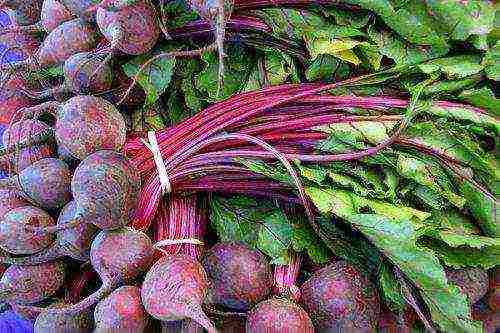
Beetroot is a very healthy vegetable
History of appearance
As a species, sugar beet has been known to mankind since antiquity; archaeologists often find fossilized seeds of this culture during excavations. This fruit was first recognized in the Mediterranean and Asia. Now the roots of the plant, the fruit itself, are used for food. But in ancient times, leaves were eaten. But the root, in those days, was used for medicinal purposes. Later, traders brought beets to Europe, where they were also able to appreciate all the useful properties of this vegetable.
Beet varieties for feed were bred in Germany in the 16th century, but table and sugar varieties were produced later.
Interesting fact. In some ancient countries, such as Persia, ancient Rome and Turkey, this root vegetable was a symbol of strife. True, this did not prevent them from eating it.

Fodder beets are one of the first types
Today, in most countries, varieties of sugar beets are grown. Selectors in Europe were involved in breeding such species. The fact that there is a large amount of sucrose in beets initially became known to the scientist Marggraf. To speed up the process of breeding new sugar beets, Napoleon also put in a lot of effort. He wanted to destroy the sugar trade in England. For this, he even announced a prize to those who find the technology by which they will receive sugar from sweet root crops.
Still, the extraction of sugar from sugar beets has long been an expensive process. For a long time, sugar was even more expensive than honey, and in Russia it was eaten as an expensive delicacy.

Sugar beets are a source of high quality sugar
Now only the best varieties of beets are used for sugar production.
Useful properties of sugar beet
The beneficial properties of this plant are countless. It is used for:
- blood diseases;
- hearts;
- liver.
Beets are rich in vitamins C, A and group B. It contains a lot of zinc, magnesium, manganese, zinc, iron, copper!
Sugar beet:
- improves memory;
- enriches the blood with iron;
- reduces the growth of cancer cells;
- fights cholesterol.
And this is not the whole list of medicinal qualities. Cosmetologists recommend drinking the juice for healthy skin. Also, some girls with the help of a root crop maintain a slender figure.
Types of sugar beets
There is a wild sugar beet, and a cultivated one. Wild sugar has a thin root and is not eaten. We are more accustomed to beets (aka beetroot), which gardeners grow on their plots. It has a thick, round or cylindrical root.
Sugar beet is a two-year-old root vegetable.
It has rich green leaves. The fruit is elongated, cylindrical in shape and light yellow (close to white) in color. Due to the amount of sucrose, this root vegetable is used to make sugar. Thanks to this property, it got its name. Sugar beets are often used to feed animals.
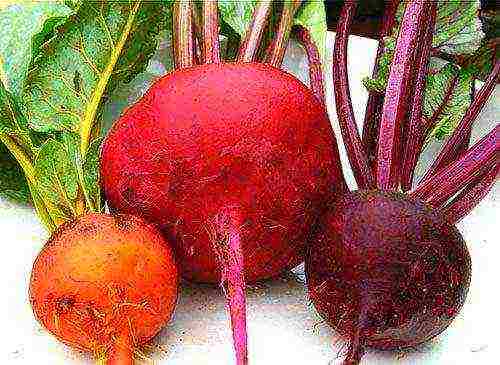
Types of beets - roots of different colors
But sugar beet varieties are used for more than just sugar production. Alcohol is made from it, and even yeast, as well as other products. It is used to make jam and moonshine. It is useful for diseases of the blood, heart and gastrointestinal tract.
Growing sweet beets
Sugar beets love sunlight and moisture. Therefore, if you are going to grow sugar beets, it is worth remembering about regular watering and weed control. Like any other plant, white beets require care and, if necessary, treatment for diseases. The earth should be loose and rich in useful trace elements. It is worth thinking about this in advance, and it will not be superfluous to fertilize the ground before planting beet seeds. You need to know that if you plan to closely engage in the cultivation of this crop, then you should not allocate the whole garden for it, the seeds are well accepted and give one hundred percent yield. It is worth allocating 20% of the plot for it, this is enough for animal feed. This is done so that the earth has time to recover. The next time on this site it will be possible to plant a crop in 3-4 years. If you want to get a crop, then do not plant in the area where legumes, cereals, flax used to grow ... They take useful microelements from the ground and greatly deplete the soil.

Growing beets can be carried out by sowing and through seedlings
The soil for planting this culture is prepared in the fall. The land should be fertilized and plowed before sowing seeds.
Since beets are a cold-resistant plant, it is possible to plant seeds in the prepared soil when the earth warms up to +6 degrees. For this, it is better to choose a sunny day. Seeds are sown in rows, the distance between the rows is 40-70 cm (as you prefer). If the weather is favorable to you, then the seed will sprout in a week and a half. Loosen the land, water and fertilize, remove weeds, and make sure that there are no pests.
Beets give good yields
When left in open ground, the crop will ripen in mid or late September.
Growing sugar beet in Siberia in open field conditions
Siberia has a rather harsh climate. There can be very cold nights even in summer, late frosts are not excluded. But even in such a harsh climate, sugar beets can be grown here. For this, the best way is to use seedlings. Plant the seeds in pots at home and wait for the seed to sprout. It is best to use selected cultivated seeds.
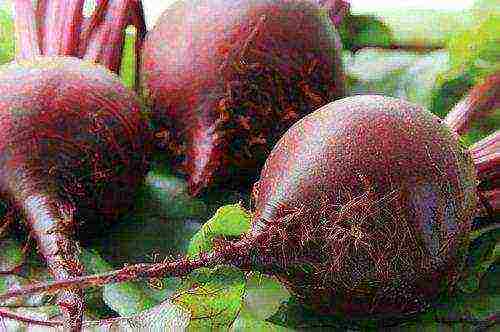
The Incomparable variety gives excellent yields in Siberia
To get a good harvest in the open ground of Siberia, it is necessary to choose cold-resistant species. Such best varieties of beets as Pablo, Cylindra, Incomparable will suit you. If you take good care of your seedlings, you can be sure that you will get the best harvest.
Beet varieties
Sugar sugar is usually divided into 3 groups:
- fruitful group - mainly beetroot;
- sugary group - one-germ;
- yielding-sugar group - the most demanded varieties of beets for consumption.
The productive group includes varieties for open ground, which bring a large harvest. The fruits themselves contain a small to medium amount of sugar.
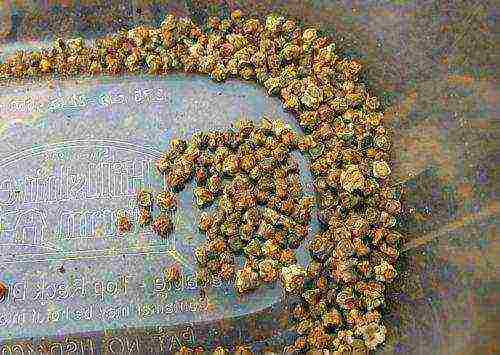
Beet seeds of different types are very similar - get them in specialized stores
The sugar group is distinguished by varieties rich in a large amount of sugar. True, this group is not very productive and is practically not grown at home.
The sugar-yielding group includes varieties with a high sugar content and are distinguished by high yields.
What are the best varieties of the sugar group?
Biysk single-seeded
Refers to the fruitful and sugary species. It has a high sugar content (up to 25%) and good tolerance to low temperatures.
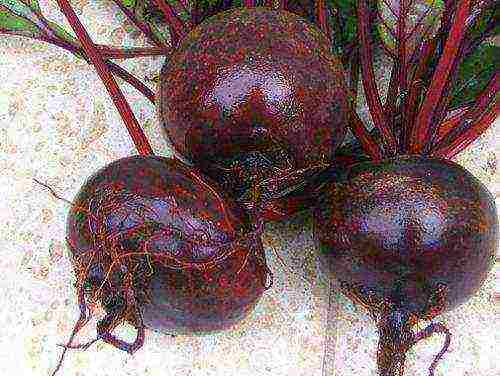
Beet variety Biyskaya
Detroit
Good early maturing variety. It tolerates cold easily. It has a round, small size. The fruit is red, juicy and sweet. This variety is fruitful and easy to store for a long time.
Crystal
This variety grows to a very large size. One fruit can be up to one and a half kilograms of net weight. Has a slightly oval shape. Differs in good resistance to various diseases of the species. Gives a good harvest.
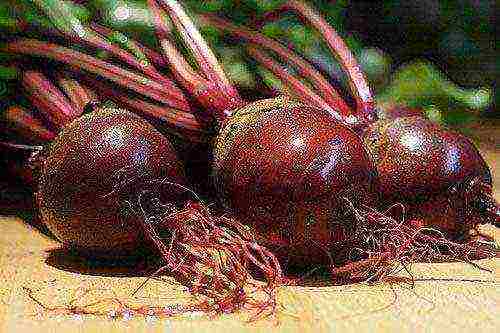
Beet variety Crystal
Bohemia
This is a fruit of average ripening time. The surface is maroon, just like the pulp, it has no rings. A juicy sweet variety, easily suitable for a garden at a summer cottage. Unpretentious. By weight it reaches up to half a kilogram apiece.
Red ball
Dark red round, very sweet flesh. The seed of this plant emerges early, as this beet is cold-resistant. Refers to the crop group. The mass of one root crop is from 200 to 500 grams.
Mulatto
It is a mid-season root crop that has a rounded shape. Over time, the pulp acquires a maroon color. It is very tasty, sugary, but not sugary, has no rings. It is valued for being well stored in winter.
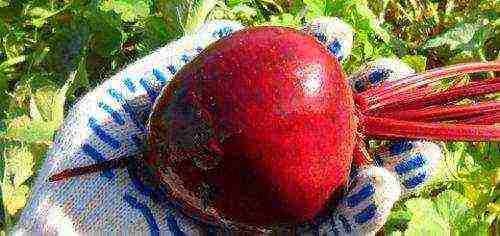
Beet variety Mulatto
Boltardi
This variety was bred by Dutch breeders. The root crop has an oval shape, ripens quickly and can be stored for a long time. It produces a good harvest and has excellent taste. Suitable for growing in gardens.
Pablo
Has a rounded shape. The pulp is red, very juicy. Gives an excellent harvest. This is a hybrid variety, recently bred. Stores well in winter. Ripens early.
Libero
The fruit is round. It grows not large, 200 g per root vegetable, unlike its other congeners, which reach 500 g. The pulp is dark red, juicy and tasty. This plant ripens early, in 80 days. This variety gives a good harvest and is resistant to various diseases of the species.

Popular varieties of beetroot
One-sprout
One-sprout is an early variety of the sugar subgroup. With proper care, the seed sprouts quickly and will take no more than 80 days to fully mature. It has a rounded burgundy color. But thinning of seedlings, single-sprout beets does not require.
Egyptian flat
It has a round, flattened shape. The ripening period reaches up to 120 days. It tolerates heat well. Suitable for southern regions. The fruits retain their freshness throughout the winter. Has a reddish-pink flesh. In terms of taste, this fruit is delicate and tasty.
Mona
The most capricious root vegetable. Requires abundant watering, thinning of the beds, and periodic groundbait. It has a dark red color, cylindrical shape, pronounced sweetish-cloying aftertaste. Ripens medium-early.
Red bullet (similar in characteristics to Mona)
The most popular type of red beet. It has a medium early ripening, 100-120 days. Outwardly, these two varieties are also similar, they both have a cylindrical shape and similar taste. By weight no more than 350 g. This beet retains useful properties even in winter.
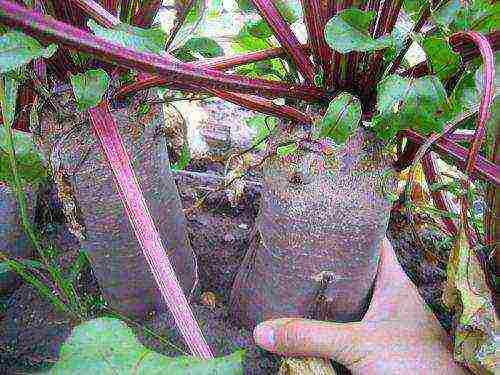
Beet variety Cylinder
Cylinder
As the name suggests, it has a cylindrical shape with smooth curves. This is the most popular variety; gardeners like it, as it is weakly susceptible to diseases. Due to its sweet taste, this fruit is easily eaten, added to borscht and salads, and not only the root vegetable is used in salads, but also the leaves of this beet. Housewives use it in preserves.
The use of sugar beet
Sugar beet is a two-year-old root vegetable. Since this plant contains a lot of sucrose, it is used to make sugar. This sugar is more valuable than its sugarcane counterpart.
In addition to the fact that beets are used to make borscht, salads and jams, cookies are made from them.
Doctors recommend eating the root vegetable for people suffering from anemia. Long-term intake of the pulp improves the body's immune resistance. Even a sore throat can be cured with the help of juice. To do this, take a glass of squeezed juice and add a tablespoon of honey to it. Mix the resulting solution thoroughly and gargle with it. This procedure should be performed up to six times a day. The juice is recommended even for bronchitis, pneumonia, and kidney disease. But, nevertheless, beets, along with positive properties, have negative sides. It is not recommended to eat it for people who are sick with urolithiasis.
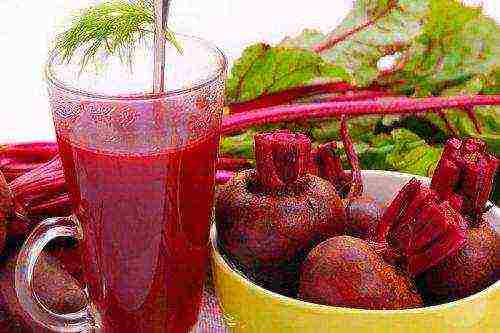
Beets can be eaten in a wide variety of forms
Farmers also use the culture in agriculture. Along with fodder, they give it to livestock and birds. Birds, thanks to such nutritious complementary foods, quickly gain weight.
Beets are practically waste-free. After processing, molasses remains, and alcohol, glycerin, citric acid, and other products are already made from it.
Subscribe Be aware of new products on our site
